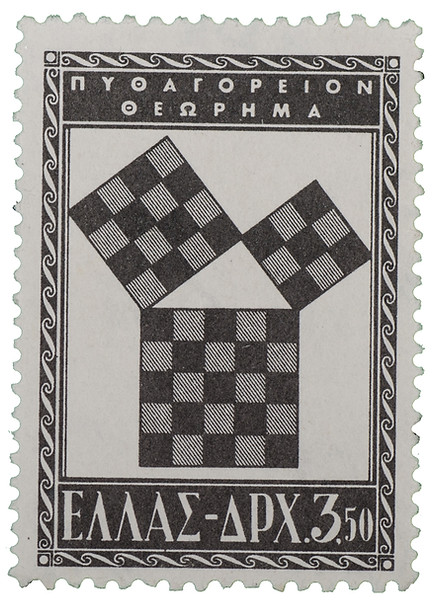The Most Influential
People in History

Pythagoras of Samos / pi-THAHG-uh-rus /
c. 560–480 B.C.E.
Greek Philosopher and Mathematician
Mathematics Ranking 11th of 46

A visual picture of the Pythagorean theorem using a 3-4-5 right triangle. Greek stamp from 1955 commemorating the 2,500th anniversary of the founding of the first school of philosophy by Pythagoras.
Pythagoras of Samos was the founder of the Pythagorean brotherhood that, although religious in nature, formulated principles that influenced the thought of Plato and Aristotle. The brotherhood also contributed to the development of mathematics and Western rational philosophy. It is difficult to distinguish Pythagoras’ teachings from those of his disciples. None of his writings has survived. Pythagoras is generally credited with the discoveries of the incommensurability of the side and diagonal of a square, and the Pythagorean theorem for right angles. However, these discoveries were probably developed only later by the Pythagorean school.(1) In astronomy, his analysis of the courses of the sun, moon, and stars into circular motions was not set aside until the seventeenth century.(2)
Mathematics–Geometry
The incommensurability of the side and diagonal of a square means that there is no length that could serve as a unit of measure of both the side and diameter; that is, the side and diameter cannot each equal the same length multiplied by (different) whole numbers. Accordingly, the Greeks called such pairs of lengths “incommensurable"(3); today we use the term irrational. For example, in the right triangle with the two shorter sides both equal to 1, the longest side, or hypotenuse, would be the square root of 2, an irrational number. An irrational or incommensurable number cannot be expressed as a whole number such as the square root of 2, i.e., √2, which is about 1.41421. In contrast, the square root of 25 is the whole number 5, i.e., √25 = 5, and therefore not irrational. Many early civilizations discovered these vexing quantities, but it was not until modern European mathematicians in the late 1500s began using decimal notation that the full explanation of these “monster” numbers came about.
The Pythagorean theorem is one example, among many, where the Greeks created a general solution for a class of problems instead of treating individual problems separately. For instance, one might discover by trial that a right angle appeared in triangles not only with sides three, four, and five feet long but also in those 5, 12, and 13 feet and of 7, 24, and 25 feet. But these were merely numbers without meaning. Could some common property be found that would describe all right triangles? By careful reasoning, Pythagoras showed that a triangle was a right triangle if, and only if, the lengths of the sides had the relation x² + y² = z², z being the length of the longest side. The right angle lay where the sides of lengths x and y met. Thus, for the triangle with sides 3, 4, and 5 feet, squaring the sides gives 9 + 16 = 25; similarly, squaring the sides of 5, 12, and 13 gives 25 + 144 = 169. These are only two cases out of an infinity of possible ones and, as such, are trivial. What intrigued the Greeks was the discovery of a proof that the relation must hold in all cases. And they pursued geometry as an elegant means of discovering and formulating generalizations.(4) In contrast the Chinese and Babylonians used the Pythagorean theorem one thousand years before. However, these civilizations did not know that the theorem was true for every right-angled triangle.(5) It was certainly true for the triangles they tested, but they had no way of showing that it was true for all the right-angled triangles that they had not tested. The reason for Pythagoras’s claim to the theorem is that he first demonstrated its universal truth.(6)
He is said to have discovered the numerical ratios determining the intervals of the musical scale. This came about through the discovery that the sound caused by a plucked string depends upon the length of the string, and second, that harmonious sounds are given off by equally taut strings whose lengths are to each other as the ratios of whole numbers. For example, a harmonious sound is produced by plucking two equally taut strings, one twice as long as the other. In common language, the interval between the two notes is an octave. Another harmonious combination is created by two strings whose lengths are in the ratio 3 to 2; in this case, the shorter one produces a note called the fifth above that given off by the first string. In fact, the relative lengths in every harmonious combination of plucked strings can be stated as ratios of whole numbers.(7)
Footnotes:
(1) Encyclopaedia Britannica, Micropaedia, Volume 9, 1993, 15th Edition, p. 828.
(2) Judy Pearsall and Bill Trumble (editors), The Oxford Encyclopedic English Dictionary (New York, 1996), p. 1176.
(3) Encyclopaedia Britannica, Micropaedia, Volume 23, 1993, 15th Edition, p. 565.
(4) Isaac Asimov, The Intelligent Man’s Guide to Science, Vol. 1 – The Physical Sciences (New York, 1960), pp. 10-11.
(5) Joseph Needham, Science and Civilization in China, Volume 3 – Mathematics and the Sciences of the Heavens and the Earth (Cambridge, 1959), p. 21.
(6) Simon Singh, Fermat’s Enigma (New York, 1997), pp. 19-20.
(7) Morris Kline, Mathematical Thought From Ancient to Modern Times (New York, 1972), p. 148 (from “This came about”).
1